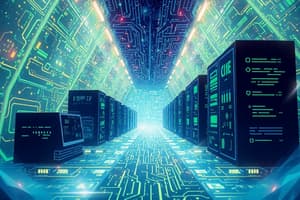Podcast
Questions and Answers
What is the primary focus of Information Communication Technology (ICT)?
What is the primary focus of Information Communication Technology (ICT)?
- Only computer hardware and software
- Only internet and web-based technologies
- Only telecommunications and networking
- The integration of computer systems, communication networks, and data storage systems (correct)
Which of the following is NOT a component of ICT hardware?
Which of the following is NOT a component of ICT hardware?
- Internet browsers (correct)
- Networking devices (routers, switches, modems)
- Servers and data centers
- Peripherals (printers, scanners, cameras)
What is the primary application of ICT in education?
What is the primary application of ICT in education?
- Digital marketing and advertising
- Remote patient monitoring and consultation
- Online learning platforms and resources (correct)
- E-commerce and online marketplaces
What is a major challenge facing ICT adoption?
What is a major challenge facing ICT adoption?
What is an emerging trend in ICT?
What is an emerging trend in ICT?
What is a major concern related to the environmental impact of ICT?
What is a major concern related to the environmental impact of ICT?
Flashcards are hidden until you start studying
Study Notes
Definition and Scope
- Information Communication Technology (ICT) refers to the convergence of computer systems, communication networks, and data storage systems to create an integrated platform for information processing, storage, and dissemination.
- ICT encompasses a broad range of technologies, including:
- Computer hardware and software
- Telecommunications and networking
- Data storage and retrieval systems
- Internet and web-based technologies
Key Components
- Hardware:
- Computers (laptops, desktops, mobile devices)
- Servers and data centers
- Networking devices (routers, switches, modems)
- Peripherals (printers, scanners, cameras)
- Software:
- Operating systems (Windows, macOS, Linux)
- Productivity applications (Microsoft Office, Google Workspace)
- Internet browsers and email clients
- Specialized software (graphic design, video editing, etc.)
- Networking and Communication:
- Internet protocols (TCP/IP, HTTP, FTP)
- Wireless communication technologies (Wi-Fi, Bluetooth, 5G)
- Network architectures (LAN, WAN, MAN)
- Data Storage and Retrieval:
- Database management systems (relational, NoSQL, graph databases)
- Data storage devices (hard drives, solid-state drives, cloud storage)
Applications and Impact
- Education:
- Online learning platforms and resources
- Digital classrooms and virtual field trips
- Access to educational resources and opportunities
- Healthcare:
- Electronic health records and telemedicine
- Medical research and data analysis
- Remote patient monitoring and consultation
- Business and Commerce:
- E-commerce and online marketplaces
- Digital marketing and advertising
- Supply chain management and logistics
- Government and Society:
- E-government and citizen engagement
- Digital governance and public policy
- Social media and online civic participation
ICT Trends and Challenges
- Emerging trends:
- Artificial intelligence and machine learning
- Internet of Things (IoT) and smart devices
- Cloud computing and edge computing
- Cybersecurity and data privacy
- Challenges:
- Digital divide and unequal access to ICT
- Cybersecurity threats and data breaches
- ICT infrastructure and maintenance costs
- Environmental impact of ICT (e-waste, energy consumption)
Studying That Suits You
Use AI to generate personalized quizzes and flashcards to suit your learning preferences.



